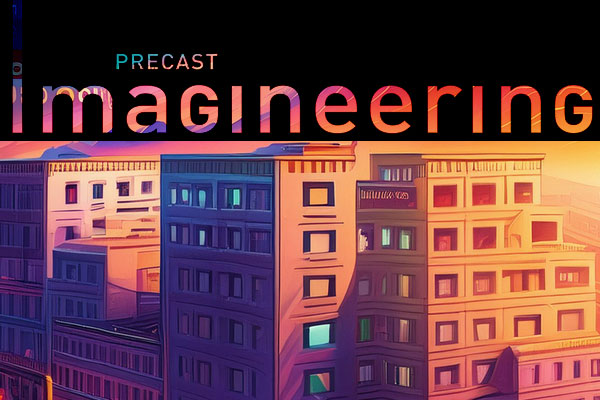Whole-Building LCA Highlights Lower-Carbon Construction at Harvest Apartments
Harvest Apartments Leverages FastTrack Modular System
By: Steven Van Wyk
The Harvest Apartments Building A, is an eight-storey multi-unit residential building constructed in Tillsonburg, Ontario, consisting of 132 units and a total floor area of approximately 12,000 square meters. This project utilizes the FastTrack by Stubbe’s Precast system, which incorporates prefabricated concrete components to streamline the design and construction process.

The building's structural and exterior elements consist of precast concrete hollowcore floors, exterior cladding walls, interior structural walls, balconies, stairs, and landings. The vinyl dual-pane windows on the precast exterior walls were pre-installed in the panels at Stubbe’s manufacturing facility before being shipped to the site, further enhancing efficiency.
The precast system drastically speeds up the process of developing, designing and constructing mid-rise residential buildings. It enables developers to build more efficiently at a competitive price through optimized pre-designed modules that can be seamlessly interchanged. FastTrack offers a complete solution, from design, fabrication of precast concrete components (hollowcore flooring, balconies, structural walls, cladding walls, and insulated walls) to installation, to bring a project to market.
Mantle Developments conducted a whole-building life cycle assessment (wbLCA) of the Harvest Apartments for Building A to quantify the upfront embodied carbon intensity (A1-A5) of the multi-unit residential building made with the FastTrack by Stubbe Precast system. The scope of the assessment was aligned with LCA regulations in North America including the Toronto Green Standard Version 4 (TGS v4). The assessment revealed a low upfront embodied carbon intensity, meeting the voluntary tier 3 embodied carbon limits set by the Toronto Green Standard v4 (TGSv4) of less than 250 kgCO2e/m2 of flooring area.

TORONTO GREEN STANDARD (TGS) EMBODIED CARBON LIMITS
In May 2023, Toronto became the first North American city to mandate lower-carbon construction materials for certain buildings under the Toronto Green Standard version 4 (TGS v4). This multi-tier standard sets limits on embodied carbon intensity, with a mandatory Tier 1 cap for city-owned buildings and a voluntary Tier 2 and Tier 3 cap for private constructions. For commercial and residential buildings, Tier 2 caps embodied carbon at 350 kg CO2e/m2, while a more ambitious voluntary Tier 3 cap sets the limit at less than 250 kg CO2e/m2.
Projects that achieve these voluntary higher levels of performance (over multiple sustainability categories, one of which is embodied carbon) are eligible for a partial development charge refund. When the next version of the TGS is published, these tiers are expected to shift, meaning that the current voluntary Tier 2 requirements would become mandatory Tier 1 requirements for private construction.

Mantle Developments based its whole-building LCA on the ‘Issued for Permit’ project documents. To assess the environmental impacts of the precast concrete components, Mantle utilized Stubbe’s Type III Environmental Product Declarations (EPDs), which provide verified data on embodied carbon and other environmental metrics for each of their precast concrete building elements.
The whole-building life cycle assessment of the Harvest Apartments Building A included the following building elements:
- Structural systems (footings, foundations, floors, walls, columns,beams, stairs)
- Enclosure systems (exterior glazing, frames, walls, insulation, roofing)
- Interior vertical finishes (gypsum and other finishes) on structural elements
Not included in the assessment were:
- Mechanical, electrical and plumbing systems
- Interior finishes not attached to structural elements
- Temporary construction works (e.g., shoring, formwork)
The results showed that the Harvest Apartments project achieved an embodied carbon intensity of 220 kgCO2e/m², which is below both the Tier 2 limit of 350 kgCO2e/m² and the Tier 3 limit of 250 kgCO2e/m² set by TGS v4. The reduction in embodied carbon can primarily be attributed to material efficiency, such as the use of hollowcore slabs, which require less material, and the optimized design of the FastTrack Precast system.
Additionally, the project benefitted from the use of lower-carbon concrete, incorporating Portland limestone cements and supplementary cementitious materials, as well as the absence of below-grade construction.
In conclusion, the use of material-efficient designs with precast concrete components, as demonstrated by FastTrack, is an effective strategy for achieving stringent carbon reduction targets today and promoting lower-carbon construction practices.
Photos: Stubbe’s Precast
- ArchitectRizz Engineering Inc.
- ArchitectGSP Group
- Precast SupplierStubbe’s Precast
- EngineerDEI Consulting Engineers
- Structural EngineerRizz Engineering Inc.
- Construction ManagerStubbe’s Development

Imagineering Magazine
View our latest issue of the popular Imagineering Magazine.
